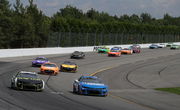
via Imago
Roger Penske Gründer und Vorsitzender der Penske Corporation Daytona United States of America *** Roger Penske Founder and Chairman of Penske Corporation Daytona United States of America

via Imago
Roger Penske Gründer und Vorsitzender der Penske Corporation Daytona United States of America *** Roger Penske Founder and Chairman of Penske Corporation Daytona United States of America
NASCAR is on a mission – to begin a new era. The sanctioning body is now focused on introducing the Gen-8 car, a potential electric series, and a multi-million-dollar marketing program. Does this ring a bell? In 2021, the sport was in a similar developmental mood, as it rolled out its Gen-7 model. Toyota President David Wilson notably said NASCAR’s Next-Gen is the “biggest change” in 50 years. However, that change has not been rewarding enough, with rival Roger Penske already catching up.
NASCAR and IndyCar have competed for higher TV ratings for decades. However, Roger Penske’s series may be getting ahead of the stock car racing series in one aspect. With the criticism of the Gen-7 car piling up even more and whispers of a newer Generation car, Penske has taken a solid step forward to develop an IndyCar model.
ADVERTISEMENT
Article continues below this ad
Is Roger Penske giving NASCAR a run for its money?
Well, many points of scrutiny have faced the Next-Gen car. Teams must buy the tubular frame chassis and other parts from NASCAR’s appointed builder, the single-spec car-building specialists Dallara. This produced greater parity on the racetracks and; therefore, less fan engagement. Then the Next-Gen’s short-track package has been a snoozer, with veteran short-track racer Dale Earnhardt Jr. not wanting to resume racing because of it. Recently, the sport’s Chief Operating Officer, Steve O’Donnell, stated, “We’re working on everything.” This pertains to a complete overhaul for the rumored Gen-8 car.
However, fans were not very pleased with NASCAR’s development plans. Now, Roger Penske may exacerbate that negativity even further. Penske Entertainment is working on its next IndyCar chassis with a significant step. Instead of showing virtual renderings of its 2027 model, the NTT IndyCar Series’ parent company is building a scale model of the car and performing wind tunnel tests with its future chassis. With all of 2025 and 2026 in their hands, Penske and Co. will benefit from real-world testing. It is important for evaluating various shapes and overall aerodynamic concepts.

This development comes after Penske Entertainment President and CEO Mark Miles revealed the new model’s plans in March. The last IndyCar chassis, the Dallara DW12, debuted in 2012. “We’re hopeful we’ll be able to roll out the next powertrain, along with major developments (to it) and a new chassis by 2027,” Miles said.
What’s your perspective on:
Is NASCAR's Gen-7 car a flop compared to Penske's innovative IndyCar developments?
Have an interesting take?
“We’re hard at work with Honda, Chevy, Ilmor, Dallara, and other major international suppliers to think about what’s possible… I think it’ll be exciting for our fan base coming with relevant technology and styling enhancements we think can score a lot of points with fans.”
Indeed, even NASCAR fans may be drawn aboard Roger Penske‘s thrilling new venture. His plan sharply contrasts with NASCAR’s approach to real-world testing.
Trending
ADVERTISEMENT
Article continues below this ad
Allowing little room to grow
In the past few years, NASCAR has taken several steps to curtail race teams’ freedom to tinker with their machines. Since the COVID-19 pandemic, the sport has taken away multiple hours of practice, reducing them to two days of on-track sessions before the actual Cup race. Instead, teams have only two 15-minute practice sessions with the field split in half based on qualifying groups.
After the Next-Gen car debuted, NASCAR restricted teams to 12 active chassis per season, allowing four alternates to be rotated in. Earlier, the number of cars that teams could use was unlimited. Notably, NASCAR’s strict wind tunnel testing rules give Roger Penske an advantage.
According to a 2020 rule, teams had a maximum usage of 70 hours in 2020 and 90 hours in 2021. Hendrick Motorsports exceeded the wind tunnel testing time permitted in 2020. Hence, NASCAR slapped the premier Cup Series team with an L2 penalty, ranging from $100,000 to $200,000. NASCAR also reduced the amount of tunnel testing time that HMS could use. The testing hours are defined as billable hours reported by the wind tunnel to NASCAR. The minimum test period is four hours.
ADVERTISEMENT
Article continues below this ad
They have only granted permissions at a few locations, like the Aerodyn Wind Tunnel in Mooresville, North Carolina, and the Auto Research Center in Indianapolis, Indiana.
Such restrictions may actually harm the sport, with no real development in sight. As Roger Penske takes strides in his series, will NASCAR also follow suit?
ADVERTISEMENT
ADVERTISEMENT
ADVERTISEMENT
ADVERTISEMENT






Is NASCAR's Gen-7 car a flop compared to Penske's innovative IndyCar developments?